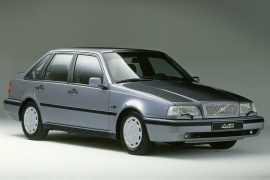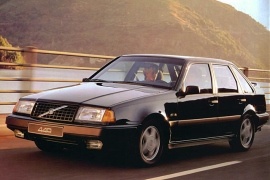VOLVO 440 Models/Series Timeline, Specifications & Photos
First production year: 1988
Engines: Gasoline, Diesel
Body style: Hatchback
Volvo introduced the 400 series as a replacement for the 300 lineup in the mid-'80s, and in 1993 it unveiled a facelifted version.
The 440 was a compact-sized premium vehicle, which didn't compete with anyone since it was shorter than Audi 80, BMW 3 Series, or Mercedes-Benz C-Class, which were above the compact segment in the European market.
The 440 was a five-door hatchback and was a solution for those who needed more trunk space in a smaller package and a premium feel. It also was a time when Volvo started to change its design trend from straight cut lines to curvy forms. The 1993 440 featured restyled headlights when compared to those of the 1987 version. Its front fascia resembled the Volvo 850, which Volvo launched in 1990. Behind the rear doors, the carmaker included a triangular glass area in the wide C-pillar. The 440 wasn't just like a regular hatchback since the tailgate featured a flat horizontal area behind the bottom of the rear windscreen.
Inside, the 440 still used the same square design. Volvo's designers combined the instrument cluster and the center stack into a big, square element with the air vents and the tape player. The car featured a roomy interior, despite its short length. It was good for transporting up to five adults on short distances, but four of them could fit nicely inside. When folded, the 440's rear bench expanded the trunk from 330 liters (11.6 cu-ft) up to 1,028 liters (36.3 cu-ft). A significant improvement for the car was the reinforcing steel beams inside the doors, which increased the passengers' protection during a side accident (T-bone).
Volvo offered the 440 with a choice of diesel and gasoline engines ranging between 83 hp and 120 hp.
Volvo introduced the model 440 in 1987 as a replacement for the 300 series, which was already old, and built it on the same platform as the successful 480 model.
While the 480 was a three-door hatchback with a sporty flavor thanks to its pop-up headlights, the 440 aimed at those who were looking for a premium vehicle but shorter. The premium German carmakers didn't have anything to oppose it since the Audi 80, BMW 3 Series, and the Mercedes-Benz C-Class were longer. Moreover, none of them were hatchbacks.
Its front fascia resembled the 740/760 series but shrunk to fit. By those times' standards, it was considered a compact-sized vehicle. From its profile, the 440 featured angular shapes, and behind the rear doors, it added generous triangular, raked-forward windows. Thus, the carmaker diminished the blind spots. At the back, the squared taillights were wide, thus reducing the trunk's opening.
The cabin was quite roomy for a car of this size. Thanks to the change toward a front-wheel-drive platform, there was less intrusion in the cabin from the engine and gearbox. That allowed the carmaker to push the front seats forward, leading to more legroom for the rear-seat passengers. At the back, the split-folding bench proved to be useful for loading long items or bulkier luggage.
Under the hood, Volvo installed a wide range of engines, either supplied by Renault or built in-house. They were paired to a standard 5-speed manual gearbox. A four-speed automatic transmission was offered as an option, while Volvo developed and installed a CVT on later versions.

